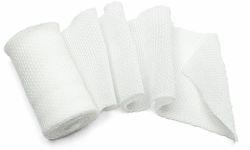Overview: Petrolatum Impregnated Gauze Wound Dressings
November 20, 2014
By Keval Parikh and James McGuire DPM, PT, CPed, FAPWHc
There are many different kinds of wound dressings available. Choosing one to use depends on the unique characteristics of the wound. According to Watson and Hodgkin, the ideal wound dressing should exhibit a number of characteristics by providing the following: moisture and exudate management, prevention of saturation and strikethrough, diffusion of wound gases, microorganism protection, mechanical protection; localized temperature and pH control; removal/change comfort; wound odor management; cosmetic acceptability; non-allergenic composition; non-contamination of the wound bed; and cost-effectiveness.1
Historically, gauze dressings in various forms have been used for the management of most wounds. These dressings still remain the most available and least expensive of all the dressings. The problems associated with removal of gauze, and specifically wet to dry dressings, are well known and include pain and tissue damage. This blog is regarding the use of one of the very early contact dressings used to prevent gauze from sticking to the wound and to attempt to maintain a moist wound surface, namely petroleum gauze, or petrolatum impregnated gauze dressings.
Overview and Indications
There are many reasons for wound deterioration such as desiccation and trauma from dressing removal. Petrolatum impregnated gauze was developed to address these two aspects to improved wound healing. Skin surface breakdown leads to a buildup of necrotic cellular debris and an increased opportunity for bacteria to form biofilms on the wound. Petrolatum gauze by virtue of its limited pore size prevents rapid evaporation from the wound and also prevents absorption by the secondary dressing of topical creams and ointments applied to address moisture or biofilm issues. The petrolatum coating also provides a hydrophilic non-adherent contact layer allowing the secondary dressing to be removed without trauma to the granulation bed, promoting faster healing.2 The dressing also conforms to the shape of the body part, which is helpful for wounds located for example, on the heel or posterior Achilles.
Contraindications
Petrolatum gauze also has its limitations. It is contraindicated in patients that have third-degree burns, long-term dressing changes, or heavily exudating wounds.3
Application
The application of a petrolatum gauze wound dressing is similar to any non-adhesive dressing. Being aware of the contraindications, the petrolatum gauze is applied over the wound bed and wrapped with more compressive dressings to keep the area occluded. Petrolatum dressings are available in a multiple formats and are available from a number of manufacturers.
References:
1. Watson NFS, Hodgkin W. Wound Dressings. Surgery 2005;23(2):52-5.
2. Reynolds L. What Is Petroleum Gauze? WiseGeek. http://www.wisegeek.com/what-is-a-xeroform-dressing.htm Updated October 21, 2014. Accessed November 19, 2014.
3. Calianno C. How to Choose the Right Treatment and Dressing for the Wound. Nursing. 2003;33:6-14.
About the Authors:
Keval Parikh is a third year podiatric medical student at Temple University in Philadelphia, PA. Keval graduated from Rutgers University in New Brunswick, NJ with a degree in Cell biology and Neuroscience. Keval wanted to broaden his education and took on a minor in Philosophy, which would teach him about the ethics and morals of making decisions.
Dr. James McGuire is the director of the Leonard S. Abrams Center for Advanced Wound Healing and an associate professor of the Department of Podiatric Medicine and Orthopedics at the Temple University School of Podiatric Medicine in Philadelphia.
The views and opinions expressed in this blog are solely those of the author, and do not represent the views of WoundSource, Kestrel Health Information, Inc., its affiliates, or subsidiary companies.
The views and opinions expressed in this blog are solely those of the author, and do not represent the views of WoundSource, HMP Global, its affiliates, or subsidiary companies.









Follow WoundSource
Tweets by WoundSource